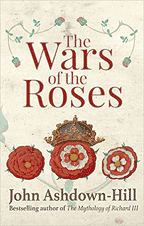Exclusive interview with author John Ashdown-Hill and a review of his new book dispelling myths about England’s civil war
Rating: Three Stars
Review by Gabrielle Pantera
 From 1455 and 1487 England experienced a series of small wars between two branches of aristocracy who were related by blood to the king. Each family wanted the throne of England. This conflict was known forever after as the War of the Roses.
From 1455 and 1487 England experienced a series of small wars between two branches of aristocracy who were related by blood to the king. Each family wanted the throne of England. This conflict was known forever after as the War of the Roses.
“In the 1990s I had written an article questioning the existence of the so-called red rose of Lancaster,” says The Wars of the Roses author John Ashdown-Hill. “Then my work on the story of Richard III showed me how full of myths are traditional historical accounts, so my exploration of the truth behind the so-called Wars of the Roses sprang from that.”
Ashdown was recently awarded an MBE in recognition of the key role he played in the rediscovery of Richard III. Most people think the War of the Roses is just one war. Ashdown shows the war was actually many skirmishes over many years.
The wars between the Lancasters and the Yorks had many battles, disputes and traitors. However, unlike the Game of Thrones TV series it inspired, there were no dragons. In smashing old myths, Ashdown-Hill traces the lives of many familiar names from history: Edward IV, his wife Elizabeth Woodville, Richard III, Warwick the Kingmaker, the Princes in the Tower and Henry Tudor. Ashdown gives so much detail that many times when he says he will dig deeper into a fact later, you never realize when he does. As with any history of this time, you have to pay close attention because many of the players had the same names. This is great reading for learning the details of the Lancaster and York fight for the crown, with photos and lots of notes.
“While working on the book I realised that there were even more questions regarding the traditional accounts of the Wars of the Roses than I had ever realised,” says Ashdown-Hill. “For example, where is the evidence that Edward IV used a white rose badge? And why are the thirteenth and fourteenth century rulers of England called Plantagenets when there is no proof that any of them ever used that surname?”
“My research on Richard III, which led to the discovery of his mitochondrial DNA sequence in 2004, together with my disproving of the story that his dead body had been thrown into a river, and my discovery of solid evidence at The National Archives which showed that he had been buried at the Franciscan Priory in Leicester, all led to the rediscovery and identification of that dead king’s remains,” says Ashdown-Hill. “He was reburied with a rosary I gave him, and a crown I had made for him lay upon his coffin while his body awaited its royal reburial.”
Ashdown-Hill doesn’t have an agent. His books have yet to be optioned for TV or film, however he has worked with the BBC. “The 2010 publication of my earlier book, The Last Days of Richard III, led to the rediscovery of his long lost remains in 2012, and their reburial in a royal tomb in 2014. I’ve also taken part in a television documentary on the story of the so-called Princes in the Tower and what became of them.”
Some of the prolific Ashdown-Hill’s books include: Eleanor The Secret Queen, Richard III’s Beloved Cousyn, Mediaeval Colchester’s Lost Landmarks, Royal Marriage Secrets, The Dublin King, and The Mythology Of Richard III. He’s also written many articles. He’s currently working on two historical research projects that are follow-ups from the search for the remains of Richard III and involve more archaeological and scientific work. Another project is researching Eleanor.
Ashdown-Hill lives near Colchester in Essex. He was born in London. There’s a list of his upcoming events and book signings on his website.
Wars of the Roses by John Ashdown-Hill. Hardcover, 336 pages, Publisher: Amberley (November 19, 2015). Language: English, ISBN: 9781445645247 $34.95
[adrotate banner=”48″]
